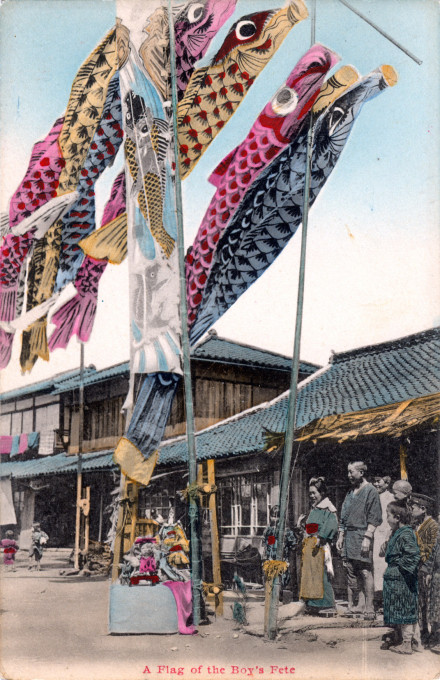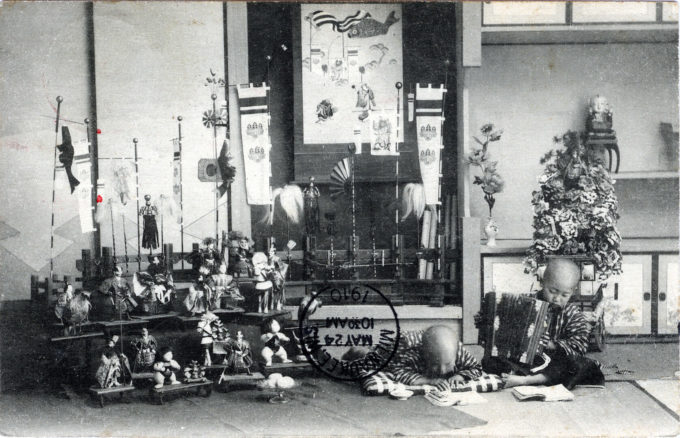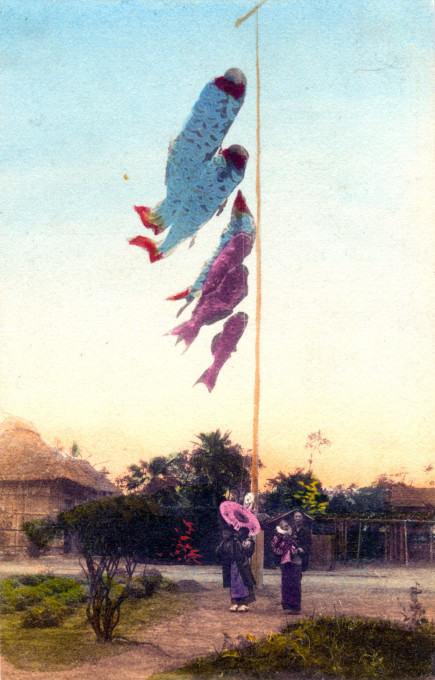
“A Flag of the Boy’s Fete”, c. 1910. Carp-shaped windsocks, Koinobori (“carp streamer”), have become universally identified with Boy’s Day – now Children’s Day – in Japan.
“In the Japanese Calendar, festivals trip closely upon one another; indeed it has been stated that for each day in the year, there is some event worth recording. Some of these festivals are local some religious and some general … Tango no sekku, which claims our attention at this present time, is the third great national feast day of the year. It falls on the 5th of June according to the old manner of [lunar calendar] reckoning because New Year’s day formerly dated from about the 11th of February, the Japanese making their months according to the lunar dates.
“The nature of the Boys’ Festival stamps it at once as one of antiquity reaching far back into the feudal days of old Japan. The day was set apart as a yearly reminder of a soldier’s career to which most young men of all ranks particularly the nobility inclined. All things which tended to inspire military ardour in youthful hearts were displayed and sustained throughout the day. Tango no sekku is also called Shobu no sekku and Ayame no sekku, both words meaning the sweet flag or iris (Acorus Calamus or Aromaticus). It is stated in a note in the second chapter of the Genji Monogatori (one of the earliest books on history, manners, customs, etc.) that the festival received the name of the feast of flags because the Ayame was at that time in full flower. Every month has its special floral tribute.
“… The main feature of the festival was the gift of suits of armour made in miniature which were laid over night upon the same place of honour as the [mochi prepared for the festivities]. They were so arranged as to meet the eyes of all aspiring youths on the first moment of their debut into the reception room to remind them the times when they would gird on their military accoutrements for their Emperor and country, and take their part in the history of their great land.
“Bundles of sweet ayame were also fixed up in the enclosures round the homes and a long staff of bamboo was erected from which was suspended a hollow paper fish this fish was the koi, or carp, which became inflated in the wind and swung hither and thither; from the mouth of the koi a nobori [paper flag] streamed down. The carp signified an heir had been born in the house a likely young samurai or fighting man of the future sons always being regarded as certain to embrace a military career.
– The Boys’ Festival or the Feast of Flags, The Asiatic Quarterly, Charlotte M. Salwey, July-October 1896

Boys’ Festival display, 1910. Handwritten on back: “This is a card of Boys’ Festival which comes on the 5th of May. It is almost the same as girls’. The only difference is that boys display little armours, flags, and dolls of warriors. They have open-air games instead of inviting friends to dinner.”
“Japan’s contemporary ‘Children’s Day’ [Kodomo no Hi] was originally called Tango no Sekku, and was celebrated on the 5th day of the 5th moon in the lunar calendar. After Japan adopted the Gregorian calendar during the Meiji era, the date was moved to May 5. It was originally exclusively male celebrating boys and recognizing fathers, but has since been changed to include both boys and girls, as well as recognizing mothers along with fathers. In 1948, the government decreed this day to be a national holiday to celebrate the happiness of all children and to express gratitude toward mothers. It was renamed Kodomo no Hi [‘Children’s Day].
Koinobori aloft on Boys’ Day, c. 1910. It is said that the koi fish was chosen as a symbol for Boys’ Day because it was considered to be
“the most spirited fish – so full of energy and power that it could fight its way up swift-running streams and cascades – with the strength and determination to overcome all obstacles, able to attain high goals – all traits desired in boys.”“On this day, families raise the carp-shaped koinobori flags (carp because of the Chinese legend that a carp that swims upstream becomes a dragon, and the way the flags blow in the wind looks like they are swimming), with one carp for the father, one for the mother, and one carp for each child (traditionally each son). Families also display a Kintarō doll usually riding on a large carp, and the traditional Japanese military helmet, kabuto, due to their tradition as symbols of strength and vitality.
“Kintarō is the childhood name of Sakata no Kintoki who was a hero in the Heian period, a subordinate samurai of Minamoto no Raikou, having been famous for his strength when he was a child. It is said that Kintarō rode a bear, instead of a horse, and played with animals in the mountains when he was a young boy.
“Mochi [rice cakes] wrapped in kashiwa [oak] leaves or kashiwa-mochi [mochi filled with red bean jam] and chimaki [a kind of ‘sweet rice paste’, wrapped in an iris or bamboo leaf] were traditionally served Boy’s Day with the tradition continuing into the contemporary Children’s Day.”
– Wikipedia



Pingback: “Contrivance of Yasukuni-jinja”, Tokyo, c. 1920. | Old TokyoOld Tokyo